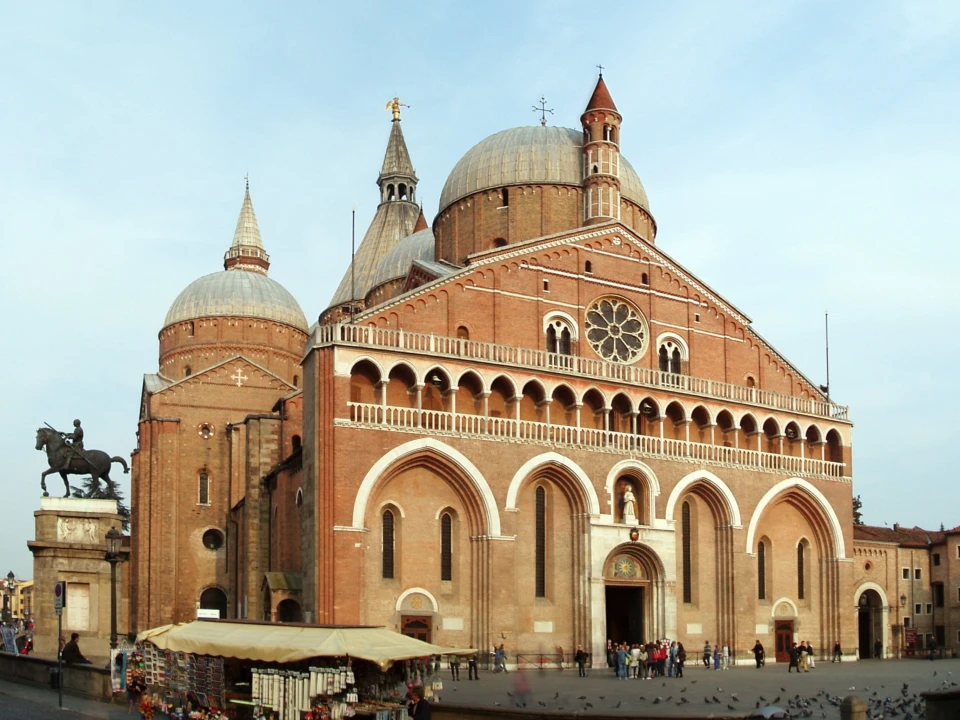The city of Padua is inextricably linked to the figure of St. Anthony, a Franciscan friar of the thirteenth century, venerated all over the world and patron of the city itself. Strenuous defender of Catholic doctrine, he fought the Cathar heresy, especially in France, with great energy and considerable success.
He moved to Padua, where he died aged 36, and, due to the miracles attributed to him, he was canonized less then one year after his death by Pope Gregory IX. His relics are preserved in the little church of Santa Maria Mater Domini, next to the monastery he founded in 1229.
This church represents the nucleus from which started the construction of the actual Basilica of Saint Anthony that now includes it as Chapel of the Black Madonna. The building of the Basilica began in 1200, but renovations and changes to the structure continued throughout the twentieth century.
Architecture
The main feature of the Basilica of St. Anthony of Padua is the harmonization of different architectural styles: in fact the facade is Romanesque, the spurs have Gothic arches, domes are Byzantine, while the two twin bell towers resemble Arab minarets.
The high altar is of undisputed value and it was made by Donatello in the middle of the 15th century. The main altar, which has lost its original architectural features, is characterized by numerous bronze sculptures, among them seven statues and 22 reliefs. The most important relief is the The Entombment of Christ, the only one that is not in bronze, but in limestone partly burnished with polychrome inserts.
The chapels
Among the places of great interest we can include: The Chapel of the Holy Sacrament. This is the first chapel the visitors can find on the right aisle, it has a squared shape, with four columns at the corners. It preserves the Eucharist. It is also known as Chapel of Gattamelata, because the family of the commander Erasmo da Narni (nicknamed Gattamelata) commissioned the its building in order to place there the commander's tomb, which can be seen in the left wall. The chapel, in Gothic style, was completed in 1458, but suffered several changes throughout the centuries.
Continuing along the right aisle, there is the transept of the Chapel of St. James and San Felice. Built in Gothic style in the 70s of the fourteenth century, the chapel was originally dedicated to St. James. However in 1503 there were also transferred the relics of San Felice. Many frescoes, among them Zevio Altichiero masterpiece “The Crucifixion”, attract visitor's attention.
Continuing on the left it is possible to reach the first chapel of the ambulatory: The Chapel of Blessings, with attractive frescoes by Pietro Annigoni. Over the centre of the ambulatory, the visitor will reach the Baroque Chapel of the Treasury, built by sculptor Filippo Parodi and containing many relics, including those of the Saint, gifts of gratitude or devotion offered by illustrious pilgrims as well as liturgical ornaments.
To the north is the Chapel of Luca Belludi Beato, containing his tomb, who has been the successor of St. Anthony, also known from the beginning as the "Ark" is the work of Tiziano Aspetti. The altar has three statues: the St. Anthony's one is at the centre, flanked by that of St. Bonaventura and St. Louis of Toulouse.
The cloisters
The tour ends with a visit to the beautiful cloisters in the Basilica, starting from the Cloister of the Novices. Made in the fifteenth century in Gothic style it offers a splendid view of the Basilica. Magnolia Courtyard: so called because of the great and beautiful magnolia tree planted in the middle of the nineteenth century cloister.
The General's Cloister: also in the Gothic style, to which the rooms of the Ministers General overlook. On the west side is housed the Anthony Exhibition.
Cloister of Blessed Luca Belludi: spectacular Gothic cloister, whose present form dates back to the late fifteenth century.
It is interesting to know
Inside the Basilica of St. Anthony of Padua is preserved the Mascioni organ opus 417, built in 1929 and restored in 2011. It has a pneumatic transmission, three keyboards of 61 notes each and a concave-radial pedalboard of 32.
In Padua, the lure of St. Anthony festivity, is strongly felt and annually attracts hundreds of visitors. The event, preceded by a long period of preparation, takes place on 12th and 13th of June, with a procession in traditional costumes, a torchlight procession on the river Bacchiglione and spectacular fireworks.




